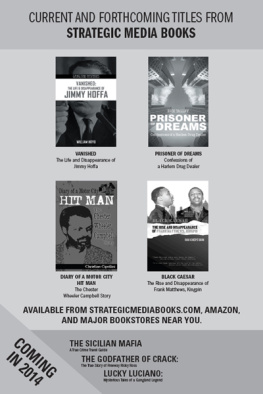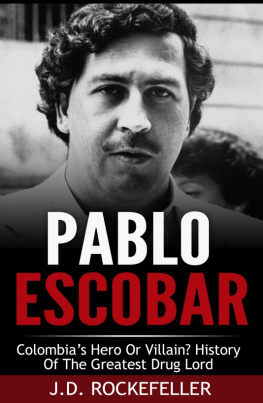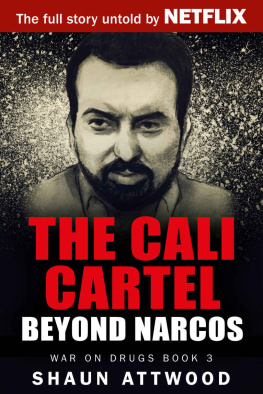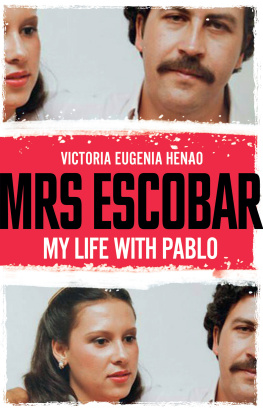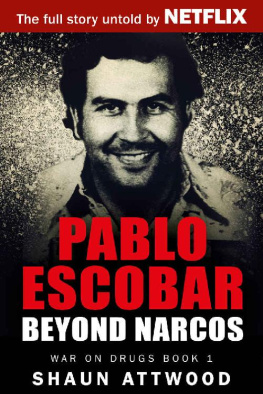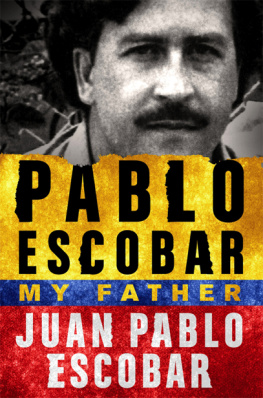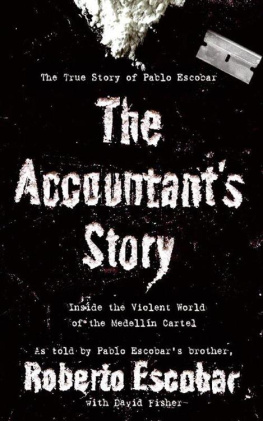GANGLAND MYSTERIES
ESCOBAR VS CALI:
THE WAR DF THE CARTELS
RON CHEPESIUK
Copyright 2013 by Ron Chepesiuk
All Rights Reserved
No part of this book may be reproduced, stored in a retrieval system, or transmitted in any form, by any means, including mechanical, electronic photocopying, recording or otherwise, without the prior written permission of the publisher, except by a reviewer, who wishes to quote brief passages in connection with a review written for inclusion in a magazine, newspaper or broadcast. Requests for permission should be directed to , or mailed to Permissions, Strategic Media Inc.,
782 Wofford St., Rock Hill Sc 29730.
13-digit ISBN 978-1939-5210-1-9
10-digit ISBN 1-9395210-1-7
eISBN 9781939521316
CONTENT
PROLOGUE
T HE FEUD BETWEEN historys two most powerful drug trafficking cartels have been brewing for some time. The mutual hatred of drug kingpins such as Pablo Escobar and Helmer Pacho Herrera was the incendiary factor. In January 1988, Pablo Escobar was in firm control of the Medellin Cartel and still considered the worlds greatest outlaw. Two years prior to that, the Colombian President, Virgilio Barco, had implemented the Colombian-US extradition treaty after the ruthless Escobar had launched vicious and violent campaigns that led to the deaths of hundreds of Colombian government officials and innocent Colombian citizens.
Pacho Herrera was one of the four founding members of the Cali Cartel, the rivals of the Medellin Cartel that had been steadily growing in wealth and power while Escobar took on the state. Herrera had returned to Cali, Colombia, from the U.S. in 1983 after a short prison term and he negotiated an arrangement with fellow Cali Cartel founders, the brothers Gilberto and Miguel Rodriguez Orejuela and Jose Chepe. Santacruz Londono offered supply and distribution rights, which had allowed him to build a base in New York City. In recognition of his value to the Cali cartel, Herrera was made a member of its board of directors, and he proved invaluable to his associates by using his contacts to help open up Mexico.
Pablo Escobar was arrogant and a bully, while Herrera was stubborn and tough. They came to hate each other over what would seem like a trivial matter: a dispute over a worker for one of Escobars New York distributors. While in prison during the early 1980s, Herrera had befriended a Colombian named Pina, a worker for Jaime Pabon, who was a major cocaine distributor for Escobar. But Pina angered Pabon when he philandered with a member of Pabons family, and he had to flee. Pina sought support from the Herrera organization.
At first, Pacho Herrera balked at hiring Pina because he knew Pabon was a close associate of the powerful and violent Escobar. He did not need to rile El Patron, or The Boss, as Escobar was known.
That did not satisfy Pabon, though, who was going unhappy until he had Pina killed for dishonoring his family. He asked Escobar for help. No problem. Escobar figured that a single call to Chepe Santacruz to complain about Pacho Herreras protection of Pina, would be enough to persuade him and the other Cali bosses to use their influences on Herrera and get him to turn Pina over to Pabon.
The Rodriguez brothers, Pacho Herrera and Santacruz had a meeting. They knew the consequences of defying Pablo, but they decided that maintaining a united front was the best response to his intimidating threat. We have no quarrel with Pina, was their terse reply to Escobar.
Pina would not let the matter go. He lied to Escobar. The Cali cartel plans to kidnap you, Pina told Escobar. The enraged Escobar called Herrera and demanded that Pina give up Pabon within 24 hours or he would kill Herreras entire family. Rather than being intimidated, Herrera took Escobars demand as a slight to his honor. There are times in the cutthroat world of drug trafficking when honor takes precedence over business. Herrera called his brother Ramon, who was managing his cell in New York City, and ordered him to hire Pina immediately.
Gilberto Rodrigues Orejuela tried to cool things down by personally contacting Escobar and trying to convince him that their two respective organizations should not go to war over such a trivial matter as the fate of a low-level worker in Queens, New York. But both sides would not back down.
The cities of Cali and Medellin were a mere 100 miles part and it seemed unthinkableand indeed foolhardy for drug traffickers, no matter how powerful they are in their own rights, to challenge Escobar. The Boss felt secured in his magnificent eight-story apartment building in Medellin. Known as Edificio Monaco, the building had paintings by Botero, Picasso and other masters worth millions and floors made of imported marbles. Made of reinforced steel, Edificio Monaco also had the first security cameras system in Colombia. It also had an underground bunker and a roof top helicopter pad where armed guards stood ready to whisk Escobar away in case of an attack by the authorities or his enemies.
The Cali Cartel godfathers tried to kill El Patron by sending Andes Freckles Velez, one of their most loyal soldiers to Medellin with a carload of dynamite. Velez had reportedly killed one of his own brothers for betraying the Cali Cartel. Velez parked his car beneath the Monaco building, expecting Escobar and his family to be sleeping in the penthouse. But on this particular night, after Escobar had dinner with his family, Escobar decided to go to his farm, which was located about ten miles from Medellin. A powerful blast shook Medellin. The bomb was so powerful that most city residents heard it when it went off.
The explosion killed two security guards, wounded several people and left a crater 12-feet deep and twenty-one feet across the outside of the apartment building. Miraculously, Escobars wife Maria and their two children survived, although the explosion partially deafened their infant daughter, Manuela, who was sleeping in a crib.
Two right-wing groups immediately claimed responsibility for the attack, declaring that their intent was to rid Medellin of criminals and drug traffickers. But The Patron had no doubt who was behind the attack. Gilberto Rodriguez Orejuela had called Escobar about half an hour after the bombing.
I heard about the bombing, Pablo, Gilberto said. Are you okay?
Escobar played dumb, but he was already thinking how he could exact revenge. He had long suspected that his rivals could not be trusted.
In the wake of the attack, Escobar sent sicarios, or hit men, to Cali to find his enemies and kill them. Figuring that the best defense was a good offense, the Cali godfathers sent hit men to Medellin.
The war of the cartels was on.
CHAPTER ONE
THE RISE OF EL PATRON
I N THE MID 1990s, no one could have imagined a gang war in Colombia that threatened the security of the state and terrorized its populace. At that time, drug traffickers were shipping a few hundred kilos of cocaine at a time, not the multi-ton shipments that would become common by the 1980s. The cocaine kingpins of the mid-1970s relied not on ships, boats and trucks but on mules individuals who carried drugs into the United States in hollowed-out platform shoes, double-bottomed suitcases, stuffed animals or various containers. The cocaine was hermetically sealed in plastic bags and normally packed in half-kilogram units. The mules were usually Colombians recruited while applying for visas to enter the United States. Some of the future drug barons, such as Pablo Escobar and Jose Santacruz, are believed to have started in the trade as mules. The few petty smugglers the U.S. authorities caught were merely deported to Colombia, where they were seldom prosecuted.
Heroin, not cocaine, was the main illegal drug on the DEAs radar screen in the mid 1970s. Yet, times were changing. For much of the twentieth century, cocaine had been mainly the drug of the elite and the jazz and Hollywood scenes, and because of its high cost, it became known as the champagne of drugs. The so-called psychedelic revolution of the 1970s revived interest in drugs of all kinds and people began to view cocaine as a relatively safe high. Meanwhile, the DEAs lack of interest reflected the attitude of the U.S. government at all levels toward cocaine. In September, 1975, for example, a drug task force established by President Gerald Ford issued an report, concluding that cocaine was not physically addictive and usually has not resulted in serious social consequences, such as crime or hospital emergency admissions, or both. The Task Force recommended that U.S. law enforcement focus on drugs, such as heroin, amphetamines and mixed barbiturates, which, it believed, posed more risk.
Next page
